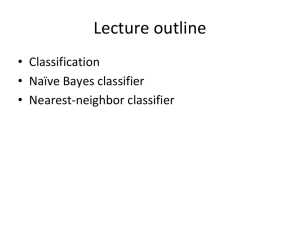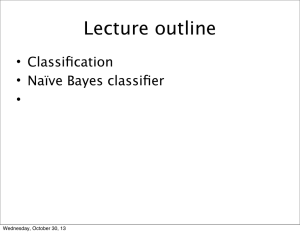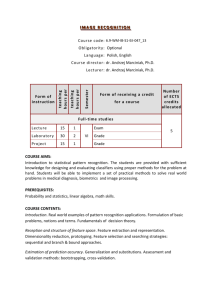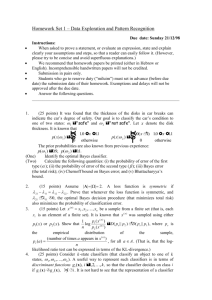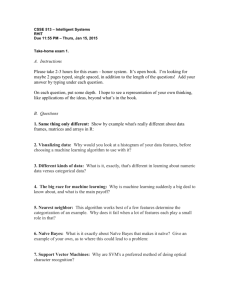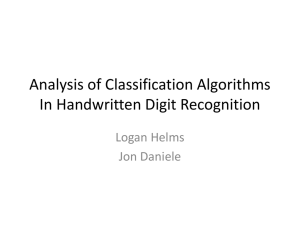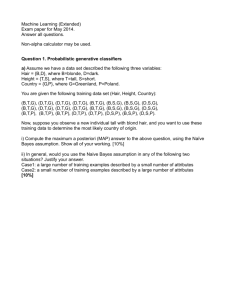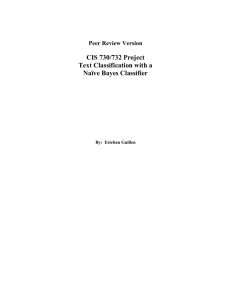Pr(Y|X
advertisement
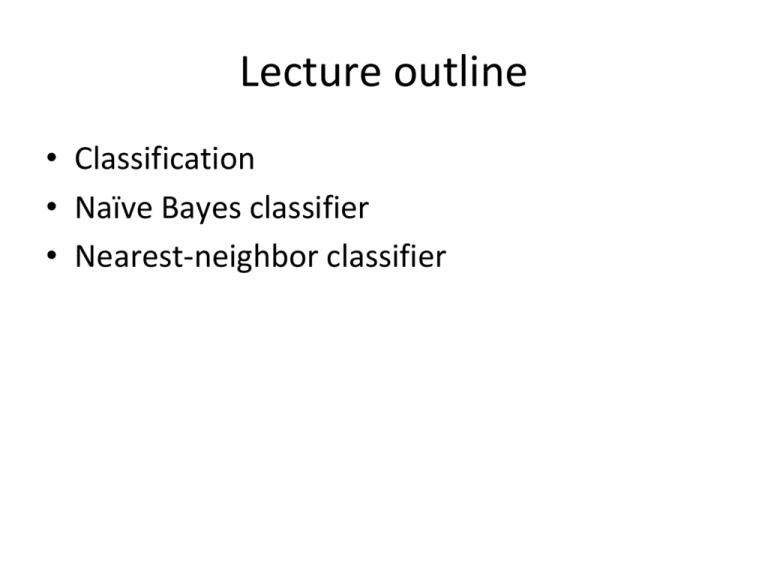
Lecture outline
• Classification
• Naïve Bayes classifier
• Nearest-neighbor classifier
Eager vs Lazy learners
• Eager learners: learn the model as soon as the
training data becomes available
• Lazy learners: delay model-building until
testing data needs to be classified
– Rote classifier: memorizes the entire training data
k-nearest neighbor classifiers
X
(a) 1-nearest neighbor
X
X
(b) 2-nearest neighbor
(c) 3-nearest neighbor
k-nearest neighbors of a record x are data points that have
the k smallest distance to x
k-nearest neighbor classification
• Given a data record x find its k closest points
– Closeness: Euclidean, Hamming, Jaccard distance
• Determine the class of x based on the classes
in the neighbor list
– Majority vote
– Weigh the vote according to distance
• e.g., weight factor, w = 1/d2
– Probabilistic voting
Characteristics of nearest-neighbor
classifiers
• Instance of instance-based learning
• No model building (lazy learners)
– Lazy learners: computational time in classification
– Eager learners: computational time in model
building
• Decision trees try to find global models, k-NN
take into account local information
• K-NN classifiers depend a lot on the choice of
proximity measure
Bayes Theorem
•
•
•
•
X, Y random variables
Joint probability: Pr(X=x,Y=y)
Conditional probability: Pr(Y=y | X=x)
Relationship between joint and conditional
probability distributions
Pr( X , Y ) Pr( X | Y ) Pr(Y ) Pr(Y | X ) Pr( X )
• Bayes Theorem:
Pr( X | Y ) Pr(Y )
Pr(Y | X )
Pr( X )
Bayes Theorem for Classification
•
•
•
•
X: attribute set
Y: class variable
Y depends on X in a non-determininstic way
We can capture this dependence using
Pr(Y|X) : Posterior probability
vs
Pr(Y): Prior probability
Building the Classifier
• Training phase:
– Learning the posterior probabilities Pr(Y|X) for
every combination of X and Y based on training
data
• Test phase:
– For test record X’, compute the class Y’ that
maximizes the posterior probability
Pr(Y’|X’)
Bayes Classification: Example
X’=(Home Owner=No, Marital Status=Married, AnnualIncome=120K)
Compute: Pr(Yes|X’), Pr(No|X’) pick No or Yes with max Prob.
How can we compute these probabilities??
Computing posterior probabilities
• Bayes Theorem
Pr( X | Y ) Pr(Y )
Pr(Y | X )
Pr( X )
• P(X) is constant and can be ignored
• P(Y): estimated from training data; compute
the fraction of training records in each class
• P(X|Y)?
Naïve Bayes Classifier
d
Pr( X | Y y ) Pr( X i | Y y )
i 1
• Attribute set X = {X1,…,Xd} consists of d
attributes
• Conditional independence:
– X conditionally independent of Y, given X:
Pr(X|Y,Z) = Pr(X|Z)
– Pr(X,Y|Z) = Pr(X|Z)xPr(Y|Z)
Naïve Bayes Classifier
d
Pr( X | Y y ) Pr( X i | Y y )
i 1
• Attribute set X = {X1,…,Xd} consists of d
attributes
d
Pr(Y | X )
Pr(Y ) Pr( X i | Y )
i 1
Pr( X )
Conditional probabilities for
categorical attributes
• Categorical attribute Xi
• Pr(Xi = xi|Y=y): fraction of training instances in class y that
take value xi on the i-th attribute
Pr(homeOwner =
yes|No) = 3/7
Pr(MaritalStatus =
Single| Yes) = 2/3
Estimating conditional probabilities
for continuous attributes?
• Discretization?
• How can we discretize?
Naïve Bayes Classifier: Example
• X’ = (HomeOwner = No, MaritalStatus =
Married, Income=120K)
• Need to compute Pr(Y|X’) or Pr(Y)xPr(X’|Y)
• But Pr(X’|Y) is
– Y = No:
• Pr(HO=No|No)xPr(MS=Married|No)xPr(Inc=120K|No)
= 4/7x4/7x0.0072 = 0.0024
– Y=Yes:
• Pr(HO=No|Yes)xPr(MS=Married|Yes)xPr(Inc=120K|Yes)
= 1x0x1.2x10-9 = 0
Naïve Bayes Classifier: Example
• X’ = (HomeOwner = No, MaritalStatus =
Married, Income=120K)
• Need to compute Pr(Y|X’) or Pr(Y)xPr(X’|Y)
• But Pr(X’|Y = Yes) is 0?
• Correction process:
nc mp
Pr( X i xi | Y y j )
nm
nc: number of training examples from class yj that take value xi
n: total number of instances from class yj
m: equivalent sample size (balance between prior and posterior)
p: user-specified parameter (prior probability)
Characteristics of Naïve Bayes
Classifier
• Robust to isolated noise points
– noise points are averaged out
• Handles missing values
– Ignoring missing-value examples
• Robust to irrelevant attributes
– If Xi is irrelevant, P(Xi|Y) becomes almost uniform
• Correlated attributes degrade the
performance of NB classifier
